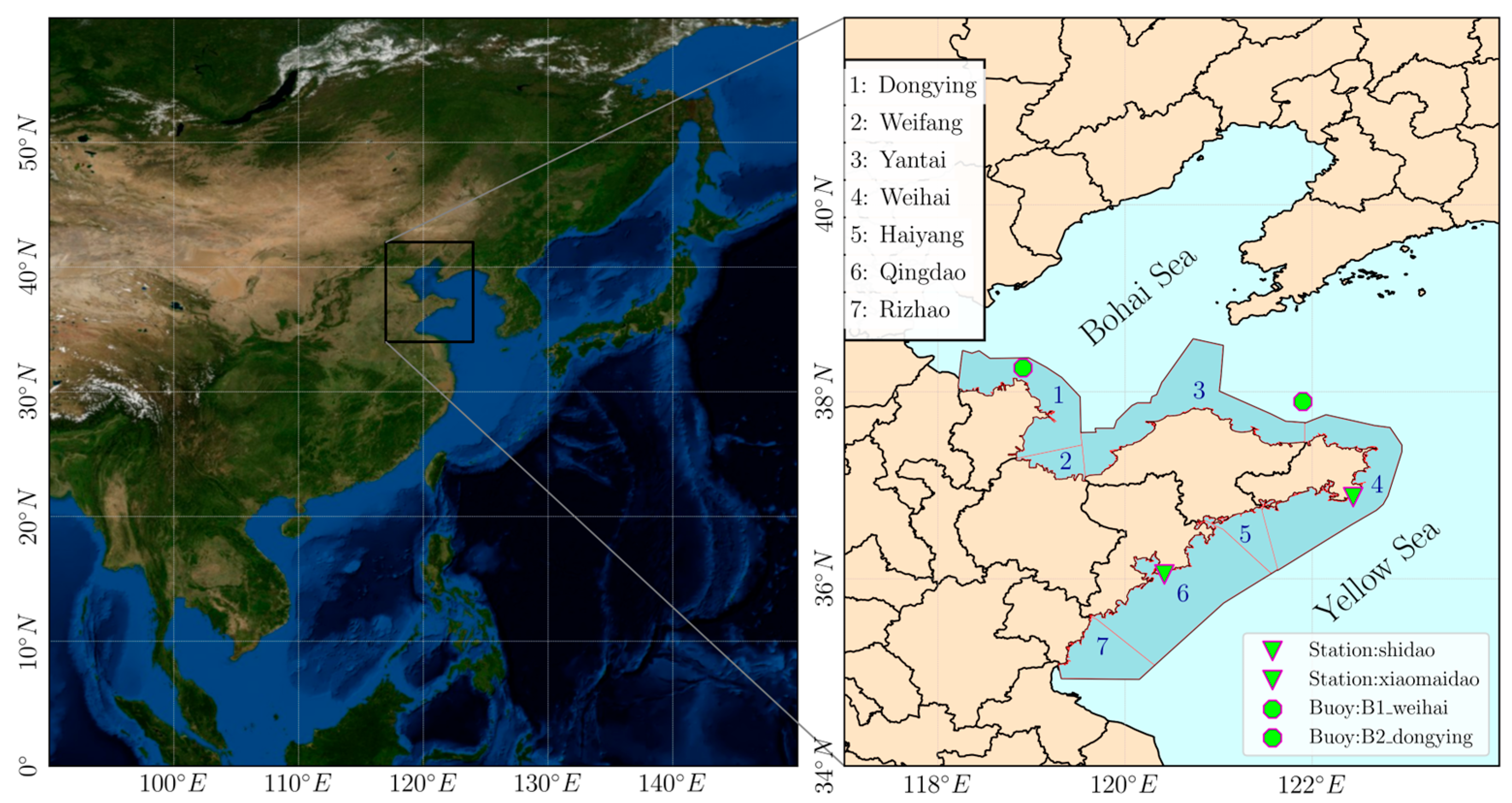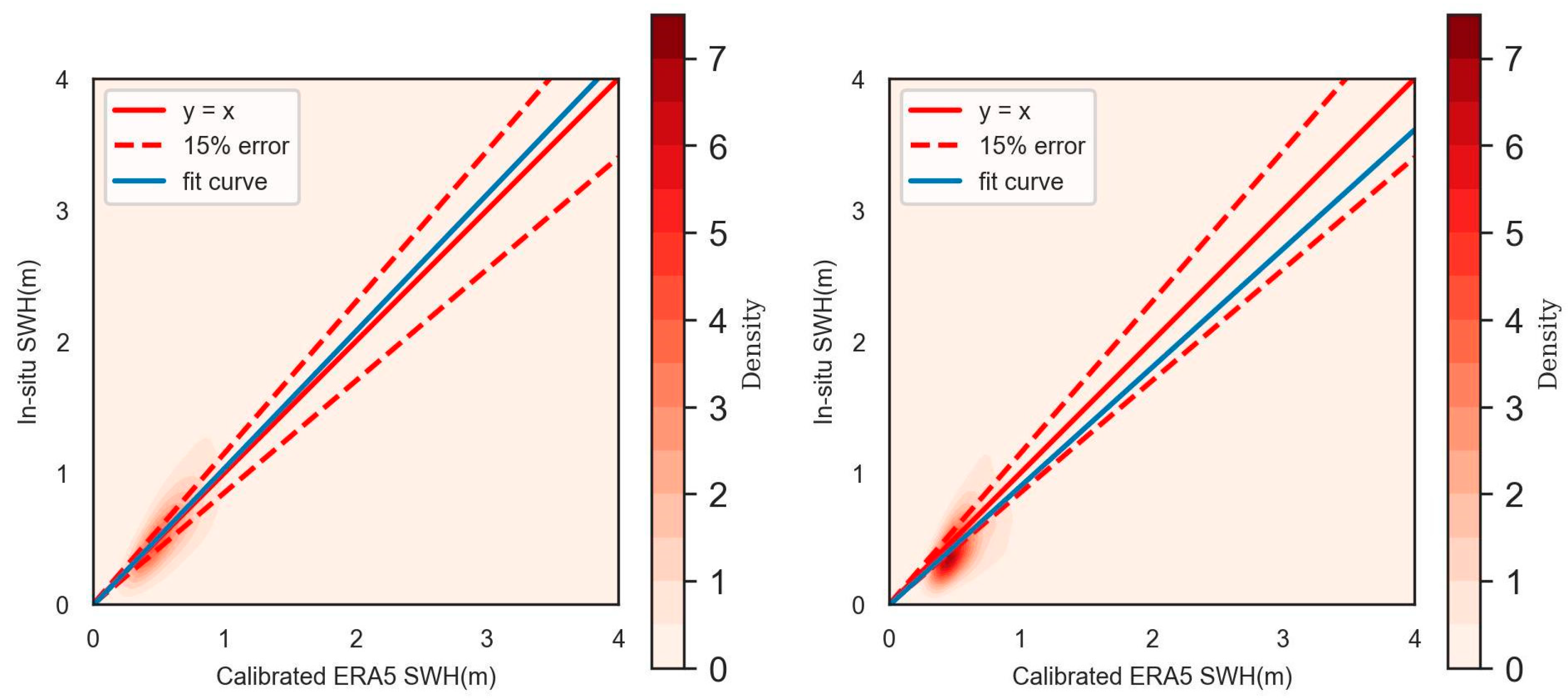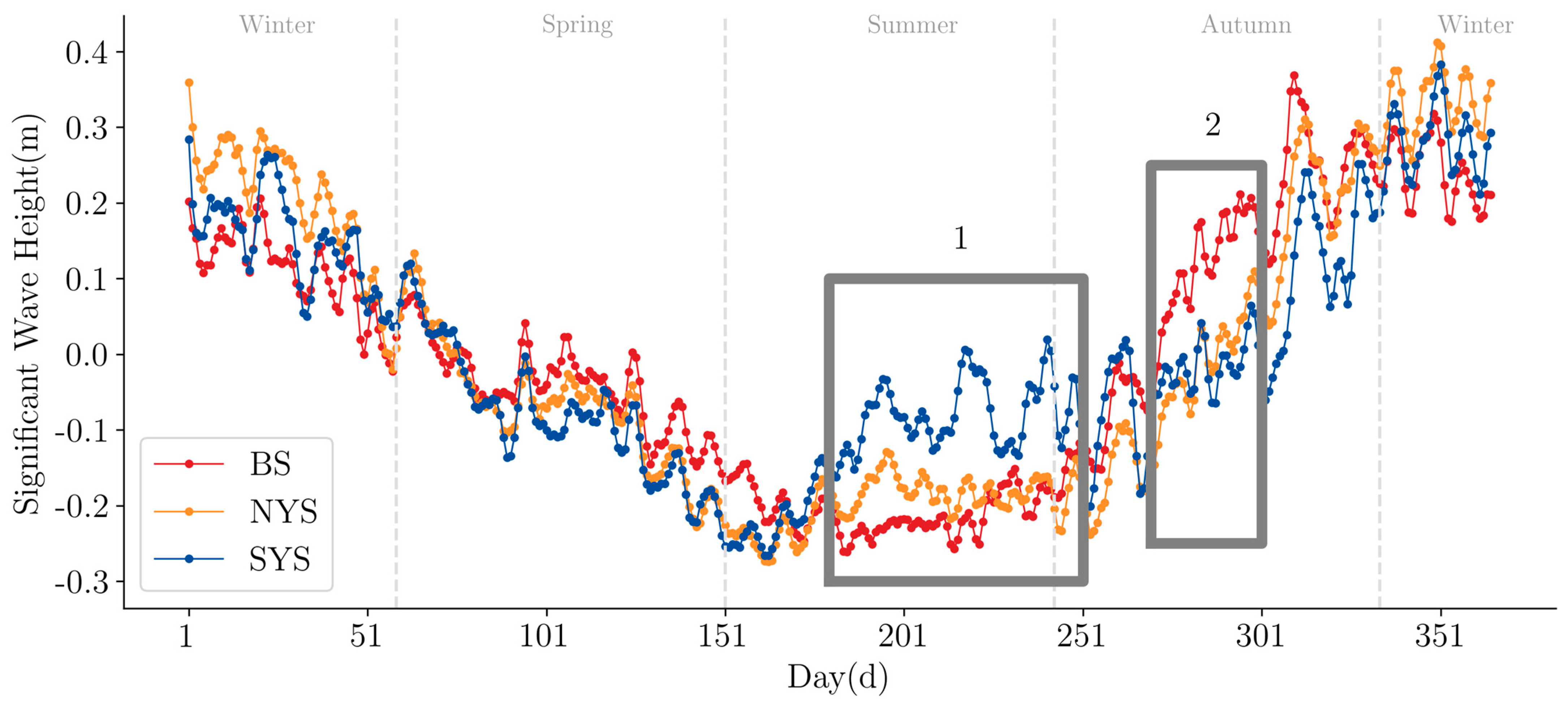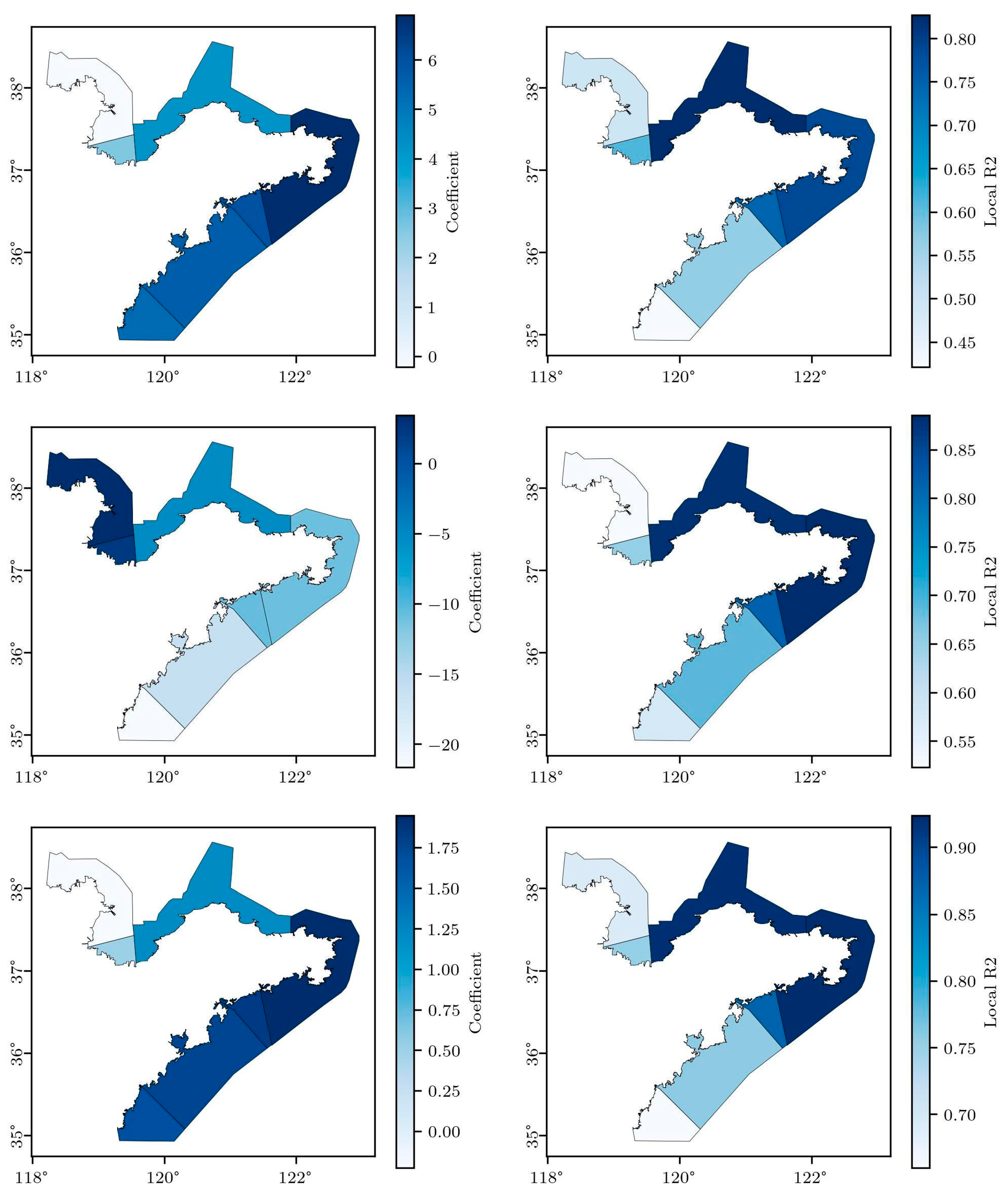Quantifying the Impact of Significant Wave Height on Mariculture Productivity: An Empirical Study in the Bohai and Yellow Seas
Abstract
1. Introduction
2. Materials and Methods
2.1. Study Area
2.2. Data Sources and Processing
2.3. Methods
2.3.1. Geographically Weighted Regression (GWR)
2.3.2. Development of SWH Indices
3. Results
3.1. Spatiotemporal Patterns of SWH in the Bohai and Yellow Seas
3.2. SWH–Aquaculture Productivity Relationships
3.3. GWR Analysis
4. Discussion
5. Conclusions
Author Contributions
Funding
Data Availability Statement
Acknowledgments
Conflicts of Interest
References
- Husain, N.T.; Hara, T.; Sullivan, P.P. Wind Turbulence over Misaligned Surface Waves and Air–Sea Momentum Flux. Part I: Waves Following and Opposing Wind. J. Phys. Oceanogr. 2022, 52, 119–139. [Google Scholar] [CrossRef]
- Buck, B.H.; Bjelland, H.V.; Bockus, A.; Chambers, M.; Costa-Pierce, B.A.; Dewhurst, T.; Ferreira, J.G.; Føre, H.M.; Fredriksson, D.W.; Goseberg, N.; et al. Resolving the term “offshore aquaculture” by decoupling “exposed” and “distance from the coast”. Front. Aquac. 2024, 3, 1428056. [Google Scholar] [CrossRef]
- Almar, R.; Ranasinghe, R.; Bergsma, E.W.J.; Diaz, H.; Melet, A.; Papa, F.; Vousdoukas, M.; Athanasiou, P.; Dada, O.; Almeida, L.P.; et al. A global analysis of extreme coastal water levels with implications for potential coastal overtopping. Nat. Commun. 2021, 12, 3775. [Google Scholar] [CrossRef] [PubMed]
- Free, C.M.; Cabral, R.B.; Froehlich, H.E.; Battista, W.; Ojea, E.; O’Reilly, E.; Palardy, J.E.; García Molinos, J.; Siegel, K.J.; Arnason, R.; et al. Expanding ocean food production under climate change. Nature 2022, 605, 490–496. [Google Scholar] [CrossRef] [PubMed]
- Karathanasi, F.E.; Soukissian, T.H.; Hayes, D.R. Wave Analysis for Offshore Aquaculture Projects: A Case Study for the Eastern Mediterranean Sea. Climate 2022, 10, 2. [Google Scholar] [CrossRef]
- Mirera, D.O.; Salim, A.; Kendi, J. Hydrodynamics of nearshore coastal waters: Implications for marine cage farming in Kenya. West. Indian Ocean. J. Mar. Sci. 2023, 22, 25–41. [Google Scholar] [CrossRef]
- Morim, J.; Wahl, T.; Vitousek, S.; Santamaria-Aguilar, S.; Young, I.; Hemer, M. Understanding uncertainties in contemporary and future extreme wave events for broad-scale impact and adaptation planning. Sci. Adv. 2023, 9, eade3170. [Google Scholar] [CrossRef]
- Lester, S.E.; Stevens, J.M.; Gentry, R.R.; Kappel, C.V.; Bell, T.W.; Costello, C.J.; Gaines, S.D.; Kiefer, D.A.; Maue, C.C.; Rensel, J.E.; et al. Marine spatial planning makes room for offshore aquaculture in crowded coastal waters. Nat. Commun. 2018, 9, 945. [Google Scholar] [CrossRef]
- Hong, J.-S.; Moon, J.-H.; Kim, T. Effect of Breaking Waves on Near-Surface Mixing in an Ocean-Wave Coupling System under Calm Wind Conditions. J. Mar. Sci. Eng. 2020, 8, 540. [Google Scholar] [CrossRef]
- Gordon, S.E.; Wingfield, M.; Smallhorn-West, P.F.; Malimali, S.a.; Halafihi, T.i.; Schoeman, D.S.; Southgate, P.C. Spatio-Temporal Variation in Growth Performance and Condition of the Winged Pearl Oyster Pteria penguin. Front. Mar. Sci. 2021, 8, 618910. [Google Scholar] [CrossRef]
- McKeown, D.A.; Schroeder, J.L.; Stevens, K.; Peters, A.F.; Sáez, C.A.; Park, J.; Rothman, M.D.; Bolton, J.J.; Brown, M.T.; Schroeder, D.C. Phaeoviral Infections Are Present in Macrocystis, Ecklonia and Undaria (Laminariales) and Are Influenced by Wave Exposure in Ectocarpales. Viruses 2018, 10, 410. [Google Scholar] [CrossRef]
- La Nafie, Y.A.; de los Santos, C.B.; Brun, F.G.; van Katwijk, M.M.; Bouma, T.J. Waves and high nutrient loads jointly decrease survival and separately affect morphological and biomechanical properties in the seagrass Zostera noltii. Limnol. Oceanogr. 2012, 57, 1664–1672. [Google Scholar] [CrossRef]
- Rijja, M.; Buriyo, A. IMPLICATIONS OF CLIMATE CHANGE INDUCED COPING AND ADAPTATION STRATEGIES ON SEAWEED PRODUCTION IN TANZANIA: A CASE OF JAMBIANI VILLAGE, UNGUJA ISLAND. Int. J. Res.-GRANTHAALAYAH 2020, 7, 47–66. [Google Scholar] [CrossRef]
- Moeser, G.; Leba, H.; Carrington, E. Seasonal influence of wave action on thread production in Mytilus edulis. J. Exp. Biol. 2006, 209, 881–890. [Google Scholar] [CrossRef] [PubMed]
- Lumor, L.; Wang, Z.; Zhao, Z.; Yang, C.; Li, J.; Deng, Y. Growth in pearl oysters: A review of genetic and environmental influences. Aquac. Res. 2019, 51, 18–28. [Google Scholar] [CrossRef]
- Xu, T.; Wang, N.; He, Y.; Li, Y.; Meng, X.; Gao, F.; Lopez-Baeza, E. GNSS Reflectometry-Based Ocean Altimetry: State of the Art and Future Trends. Remote Sens. 2024, 16, 1754. [Google Scholar] [CrossRef]
- Li, D.; Feng, J.; Zhu, Y.; Staneva, J.; Qi, J.; Behrens, A.; Lee, D.; Min, S.-K.; Yin, B. Dynamical Projections of the Mean and Extreme Wave Climate in the Bohai Sea, Yellow Sea and East China Sea. Front. Mar. Sci. 2022, 9, 844113. [Google Scholar] [CrossRef]
- Fanti, V.; Ferreira, Ó.; Kümmerer, V.; Loureiro, C. Improved estimates of extreme wave conditions in coastal areas from calibrated global reanalyses. Commun. Earth Environ. 2023, 4, 151. [Google Scholar] [CrossRef]
- Wang, J.; Wang, Y. Evaluation of the ERA5 Significant Wave Height against NDBC Buoy Data from 1979 to 2019. Mar. Geod. 2022, 45, 151–165. [Google Scholar] [CrossRef]
- Liang, G.; Yang, J.; Wang, J. Accuracy Evaluation of CFOSAT SWIM L2 Products Based on NDBC Buoy and Jason-3 Altimeter Data. Remote Sens. 2021, 13, 887. [Google Scholar] [CrossRef]
- ICES. Report of the Working Group on Marine Shellfish Culture (WGMASC); ICES CM 2011/SSGHIE:08; ICES: La Trinité-sur-Mer, France, 2011; p. 92. [Google Scholar]
- Zhao, Y.; Guan, C.; Bi, C.; Liu, H.; Cui, Y. Experimental Investigations on Hydrodynamic Responses of a Semi-Submersible Offshore Fish Farm in Waves. J. Mar. Sci. Eng. 2019, 7, 238. [Google Scholar] [CrossRef]
- Bian, C.; Jiang, W.; Pohlmann, T.; Sündermann, J. Hydrography-Physical Description of the Bohai Sea. J. Coast. Res. 2016, 74, 1–12. [Google Scholar] [CrossRef]
- Xu, X.; Gao, J.; Shi, Y.; Wu, X.; Lv, J.; Zhang, S.; Liu, S.; Liu, T.; Yang, G. Cross-Front Transport Triggered by Winter Storms Around the Shandong Peninsula, China. Front. Mar. Sci. 2022, 9, 975504. [Google Scholar] [CrossRef]
- Yuan, D.; Hsueh, Y. Dynamics of the cross-shelf circulation in the Yellow and East China Seas in winter. Deep.-Sea Res. Part Ii-Top. Stud. Oceanogr. 2010, 57, 1745–1761. [Google Scholar] [CrossRef]
- Zhen-Zhen, C.; Jian, Z.; Miao-Feng, Y.; Yong-Qing, L.; Hui-Dong, Z.; Dong-Lian, L.; Shuang-Cheng, J.; Tuan-Yu, G.; Sheng-Hua, Z. Vertical distribution and pollution assessment of TN, TP, and TOC in the sediment cores of cage farming areas in Dongshan Bay of southeast China. Front. Environ. Sci. 2023, 11, 1216868. [Google Scholar] [CrossRef]
- England, P.; Phillips, J.; Waring, J.; Symonds, G.; Babcock, R. Modelling wave-induced disturbance in highly biodiverse marine macroalgal communities: Support for the intermediate disturbance hypothesis. Mar. Freshw. Res. 2008, 59, 515–520. [Google Scholar] [CrossRef]
- Soto, I.; Muller-Karger, F.; Hallock, P.; Hu, C. Sea Surface Temperature Variability in the Florida Keys and Its Relationship to Coral Cover. J. Mar. Biol. 2011, 2011, 981723. [Google Scholar] [CrossRef]
- González-Delgado, S.; Pérez-Portela, R.; Hernández, J.C. Molecular evidence for the intermediate disturbance hypothesis in an acidified marine system. Hydrobiologia 2025, 852, 4341–4352. [Google Scholar] [CrossRef]
- Engelen, A.H.; Åberg, P.; Olsen, J.L.; Stam, W.T.; Breeman, A.M. Effects of wave exposure and depth on biomass, density and fertility of the fucoid seaweed Sargassum polyceratium (Phaeophyta, Sargassaceae). Eur. J. Phycol. 2005, 40, 149–158. [Google Scholar] [CrossRef]
- Froehlich, H.E.; Smith, A.; Gentry, R.R.; Halpern, B.S. Offshore Aquaculture: I Know It When I See It. Front. Mar. Sci. 2017, 4, 154. [Google Scholar] [CrossRef]
- Sühring, N.; Chambers, C.; Koenigk, T.; Kruschke, T.; Einarsson, N.; Ogilvie, A.E.J. Effects of storms on fisheries and aquaculture: An Icelandic case study on climate change adaptation. Arct. Antarct. Alp. Res. 2023, 55, 2269689. [Google Scholar] [CrossRef]
- Welch, A.W.; Knapp, A.N.; El Tourky, S.; Daughtery, Z.; Hitchcock, G.L.; Benetti, D.D. The nutrient footprint of a submerged-cage offshore aquaculture facility located in the tropical Caribbean. J. World Aquac. Soc. 2019, 50, 299–316. [Google Scholar] [CrossRef]
- Brenner, M.; Buchholz, C.; Heemken, O.; Buck, B.H.; Koehler, A. Health and growth performance of the blue mussel (Mytilus edulis L.) from two hanging cultivation sites in the German Bight: A nearshore—Offshore comparison. Aquac. Int. 2012, 20, 751–778. [Google Scholar] [CrossRef]
- Wang, X.; Xie, J.; Luo, Y.; Wang, X.; Guo, G.; You, X. Experimental Investigation of the Hydrodynamic Characteristics of Longline Aquaculture Facilities under Current and Wave Conditions. Fishes 2023, 8, 204. [Google Scholar] [CrossRef]
- Quaade, S.; Vallebueno, A.; Alcabes, O.D.N.; Rodolfa, K.T.; Ho, D.E. Remote sensing and computer vision for marine aquaculture. Sci. Adv. 2024, 10, eadn4944. [Google Scholar] [CrossRef]





| Type | Station | Mean/m | Pearson’s r | RMSE/m | SI/m | Bias/m |
|---|---|---|---|---|---|---|
| In situ observations | Shidao | 0.84 | - | - | - | - |
| Xiaomaidao | 0.81 | - | - | - | - | |
| B1_weihai | 0.75 | - | - | - | - | |
| B2_dongying | 0.56 | - | - | - | - | |
| ERA5 before calibration | Shidao | 0.86 | 0.80 | 0.21 | 0.25 | 0.02 |
| Xiaomaidao | 0.75 | 0.70 | 0.21 | 0.27 | −0.05 | |
| B1_weihai | 0.68 | 0.76 | 0.23 | 0.31 | −0.06 | |
| B2_dongying | 0.63 | 0.78 | 0.20 | 0.33 | 0.07 | |
| ERA5 after calibration | Shidao | 0.86 | 0.80 | 0.20 | 0.24 | 0.03 |
| Xiaomaidao | 0.78 | 0.70 | 0.20 | 0.25 | −0.03 | |
| B1_weihai | 0.73 | 0.76 | 0.21 | 0.29 | −0.02 | |
| B2_dongying | 0.56 | 0.78 | 0.18 | 0.34 | −0.01 |
| Index | Pearson’s r 1 | F-Statistic 1 | R2 | Adjusted R2 | AIC | BIC | RSS |
|---|---|---|---|---|---|---|---|
| LSDI | 0.47 ** | 4.99 * | 0.22 | 0.20 | 110.42 | 113.65 | 17.75 |
| MSDI | −0.2 | 0.73 | 0.04 | 0.01 | 118.2 | 121.43 | 21.9 |
| HSDI | −0.51 ** | 6.21 ** | 0.26 | 0.24 | 108.47 | 111.7 | 16.83 |
| RSI | 0.48 ** | 5.09 * | 0.23 | 0.20 | 110.26 | 113.48 | 17.67 |
| NDSI | 0.61 ** | 10.25 ** | 0.37 | 0.35 | 102.65 | 105.87 | 14.38 |
Disclaimer/Publisher’s Note: The statements, opinions and data contained in all publications are solely those of the individual author(s) and contributor(s) and not of MDPI and/or the editor(s). MDPI and/or the editor(s) disclaim responsibility for any injury to people or property resulting from any ideas, methods, instructions or products referred to in the content. |
© 2025 by the authors. Licensee MDPI, Basel, Switzerland. This article is an open access article distributed under the terms and conditions of the Creative Commons Attribution (CC BY) license (https://creativecommons.org/licenses/by/4.0/).
Share and Cite
Yuan, Z.; Yu, N.; Wang, J.; Han, K.; Chang, X.; Sun, G.; Zhu, M.; Zhu, J.; Yang, Y.; Qin, H. Quantifying the Impact of Significant Wave Height on Mariculture Productivity: An Empirical Study in the Bohai and Yellow Seas. Water 2025, 17, 3165. https://doi.org/10.3390/w17213165
Yuan Z, Yu N, Wang J, Han K, Chang X, Sun G, Zhu M, Zhu J, Yang Y, Qin H. Quantifying the Impact of Significant Wave Height on Mariculture Productivity: An Empirical Study in the Bohai and Yellow Seas. Water. 2025; 17(21):3165. https://doi.org/10.3390/w17213165
Chicago/Turabian StyleYuan, Zhonghao, Ning Yu, Jianping Wang, Kaili Han, Xiaoyu Chang, Guiqin Sun, Mingming Zhu, Jinlong Zhu, Yanyan Yang, and Huawei Qin. 2025. "Quantifying the Impact of Significant Wave Height on Mariculture Productivity: An Empirical Study in the Bohai and Yellow Seas" Water 17, no. 21: 3165. https://doi.org/10.3390/w17213165
APA StyleYuan, Z., Yu, N., Wang, J., Han, K., Chang, X., Sun, G., Zhu, M., Zhu, J., Yang, Y., & Qin, H. (2025). Quantifying the Impact of Significant Wave Height on Mariculture Productivity: An Empirical Study in the Bohai and Yellow Seas. Water, 17(21), 3165. https://doi.org/10.3390/w17213165





